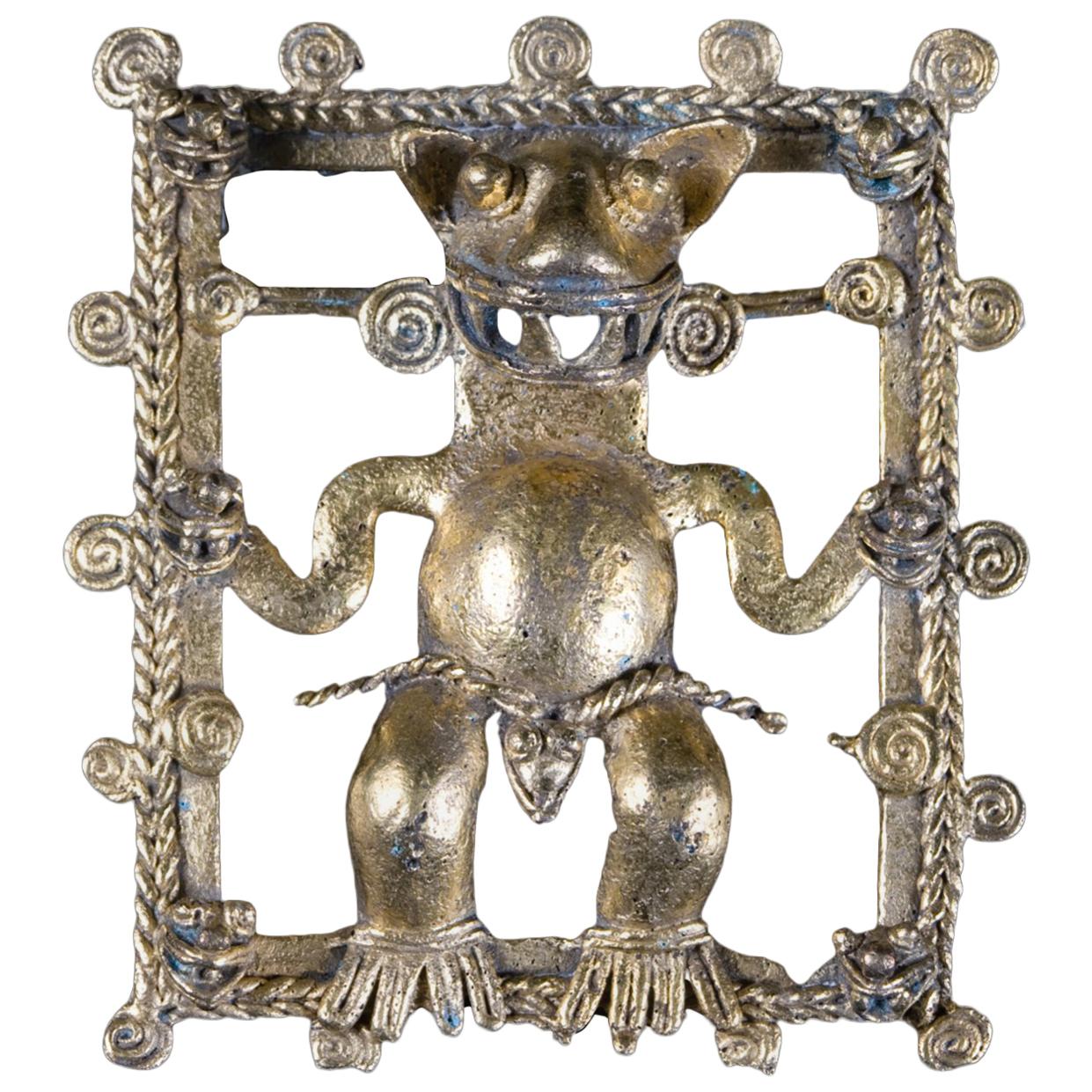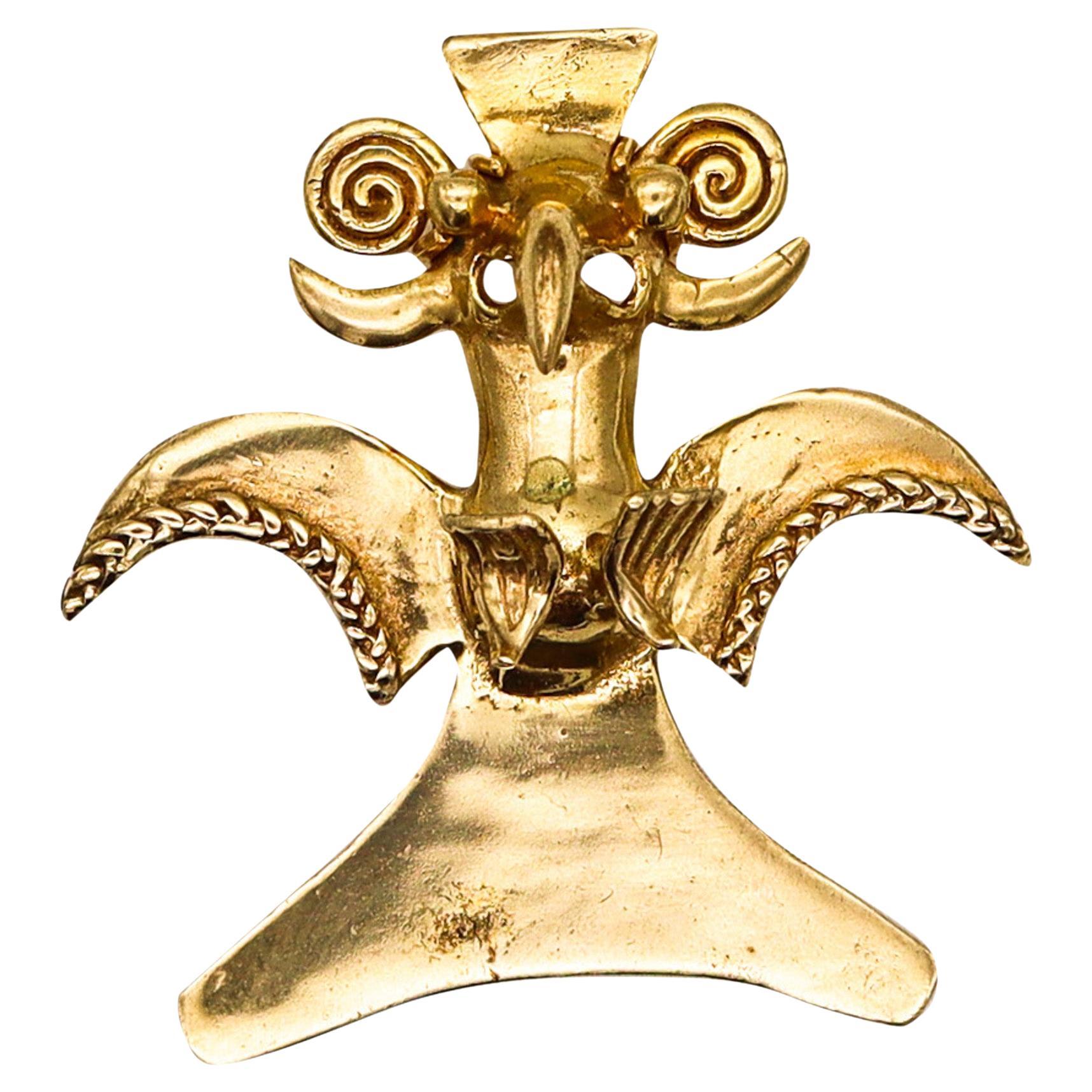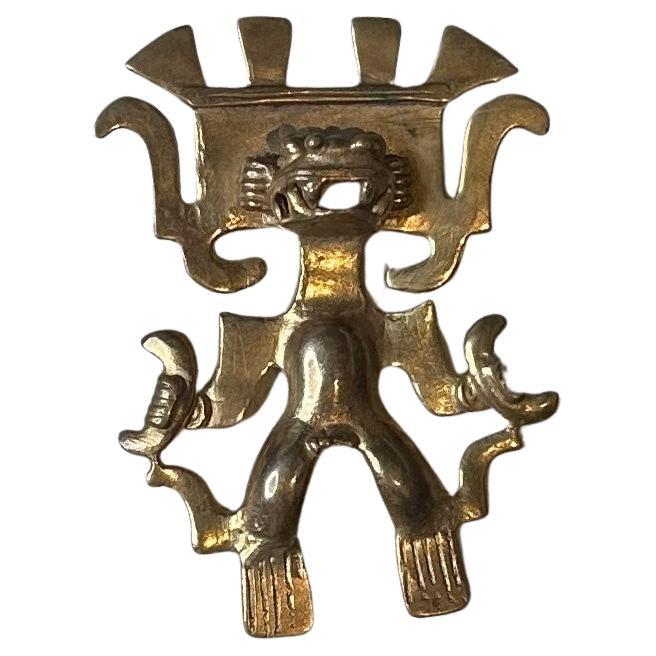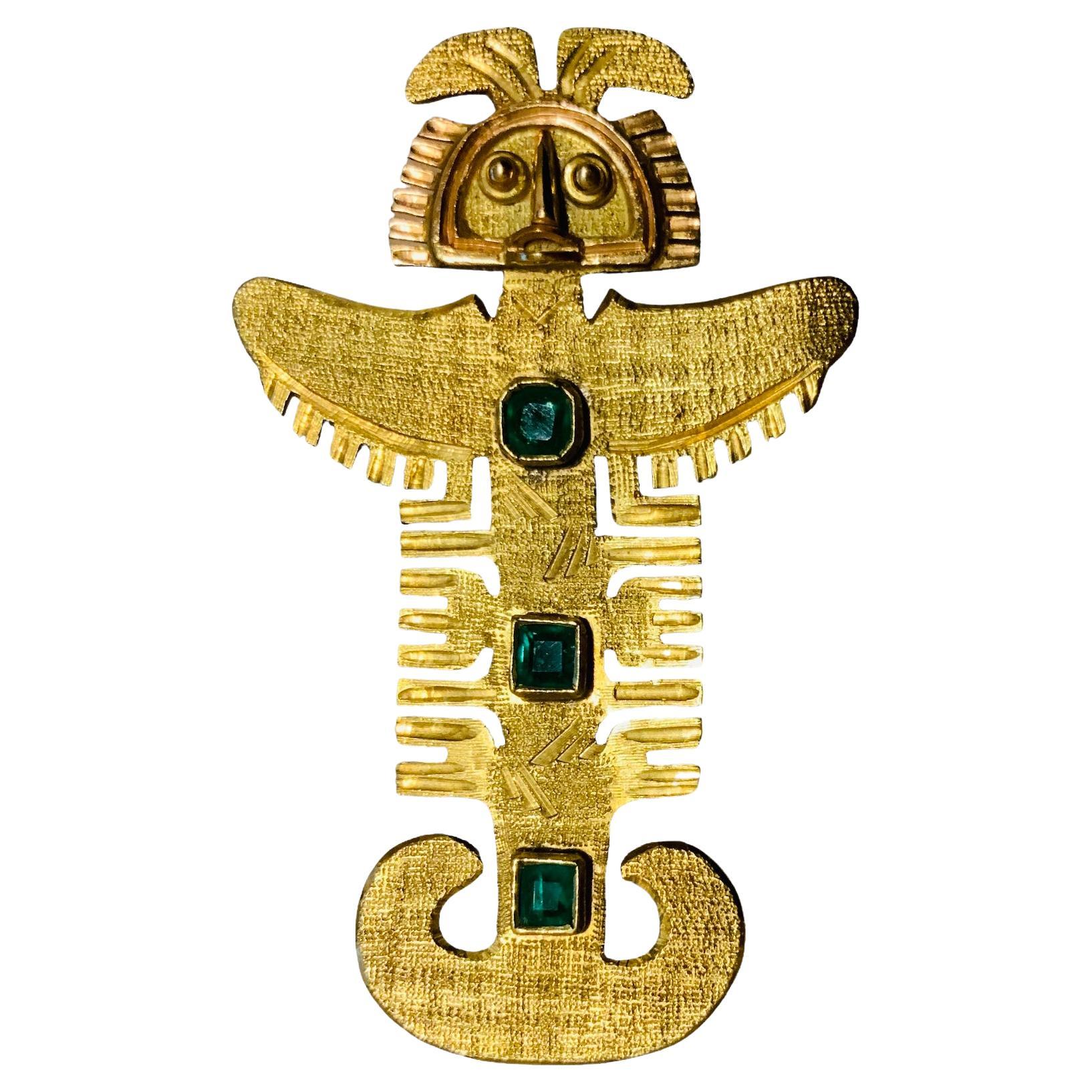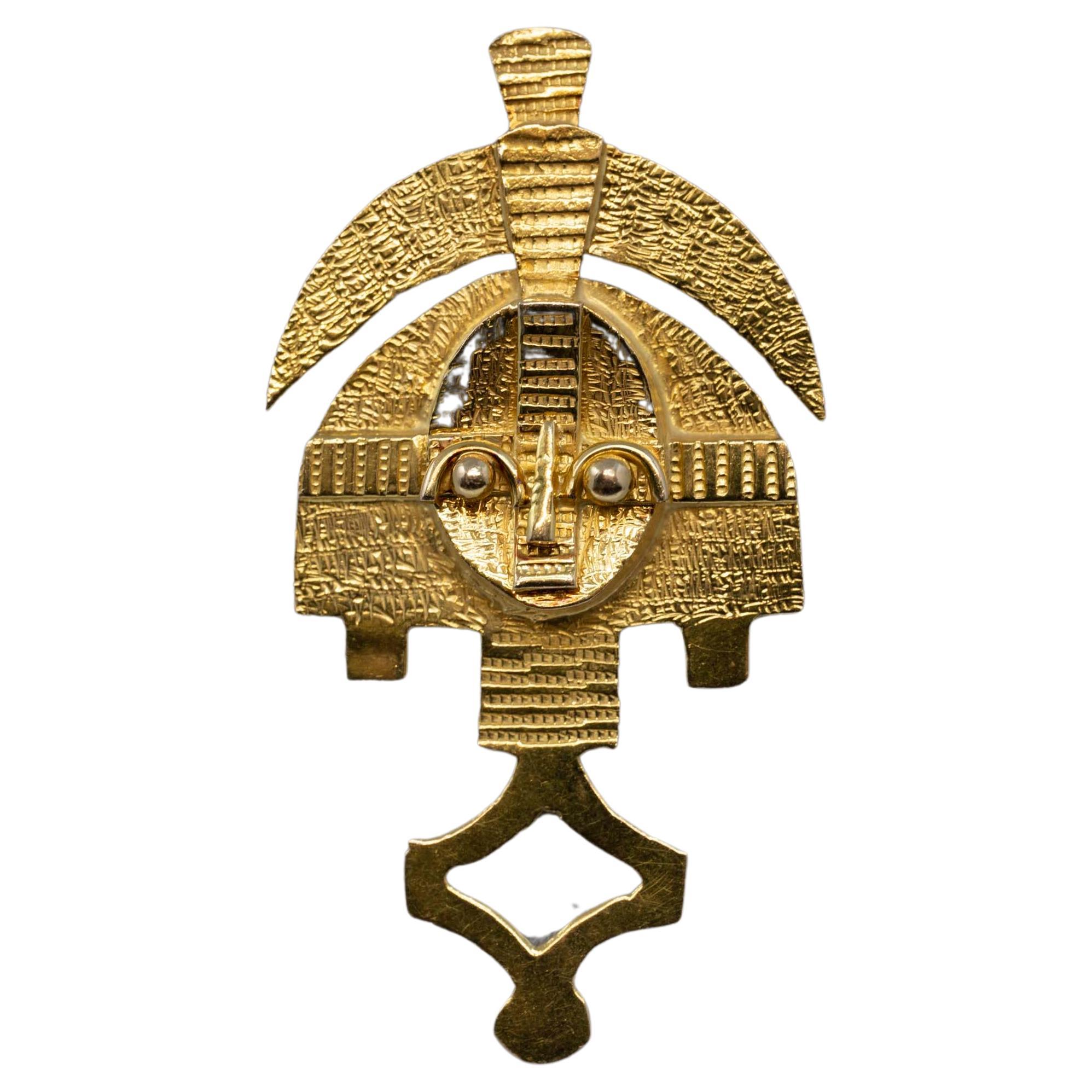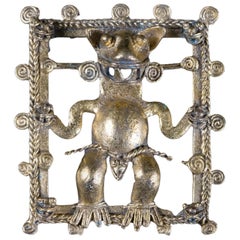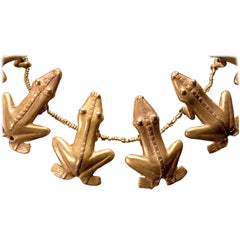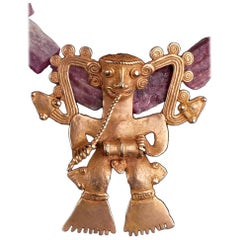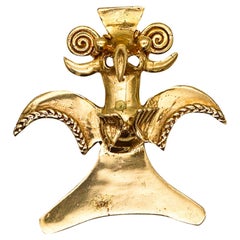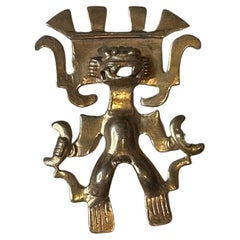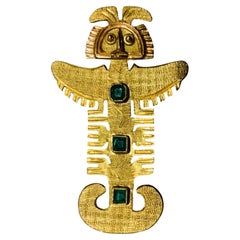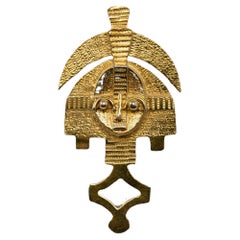Items Similar to Museum Quality Pre-Columbian Gold Twin Figures Pendant, circa 800 to 1500 AD
Want more images or videos?
Request additional images or videos from the seller
1 of 7
Museum Quality Pre-Columbian Gold Twin Figures Pendant, circa 800 to 1500 AD
$48,500
£36,601.62
€41,903.32
CA$68,401.08
A$75,095.86
CHF 39,177.67
MX$908,764.39
NOK 491,031.26
SEK 462,680.54
DKK 312,797.08
About the Item
Southern Costa Rica/Western Panama, circa 800 to 1500 AD. Gold Veraguas-Chiriqui-Diquis twin figure pendant cast by the lost-wax (cire perdu) grasping an imaginary club with their claws, with bat ears and pop out eyes and each figure ending in the shape of a jaguar tooth, symbolizing the power of the jaguar and the ability to see in the dark; The casting process did not go entirely smoothly. Part of his mold, on the side of the proper right figure (viewer's left side), did not fill with metal. The Pre-Columbian goldsmith carried out a superb repair, probably making a wax patch and pouring gate on the gold pendant, then enclosing it in a new mold and pouring in more metal. The patch is hardly visible on the outside. A modern goldsmith, who cannot do it as well, would use his gas torch to solder on a patch. The gold is of such high grade or karat, possibly unalloyed native gold, that it shows no sign of corrosion, such as we see in tumbaga, an alloy of gold and copper that Mesoamericans frequently used because of its good casting qualities. This piece comes with an authenticity letter from Mr. Rober Sonin, Feb. 1 2006. reference photo roll 3291.
In Pre-Colombian America (America before Christopher Columbus), gold was developed in the context of ritual and regalia, it was transformed into objects for gods and rulers. The earliest evidence for the working of gold in the New World comes from Peru, in South America. The first salient works were personal ornaments such as headdresses, pectorals, necklaces, ear and nose ornaments and the like. These artifacts were found in royal burials of powerful emperors. These works were often transported across great distances and handed down over generations, making them a primary means by which ideas were exchanged between regions and across time. Crucial bearers of meaning, gold was especially susceptible to destruction and transformation; thus these works are rare testaments to the brilliance of ancient American artists. Gold too was closely associated with the supernatural realm. This majestic material was meant to provoke a strong response - perceptually, sensually, and conceptually - to transport the wearer and beholder into new realms. The imagery of these early works speaks to a rich mythological world of snarling, fantastic beasts and other extraordinary beings.
- Dimensions:Height: 3.25 in (8.26 cm)Width: 5.125 in (13.02 cm)Depth: 1 in (2.54 cm)
- Style:Pre-Columbian (Of the Period)
- Materials and Techniques:
- Place of Origin:
- Period:
- Date of Manufacture:800-1500 AD
- Condition:Wear consistent with age and use. Minor structural damages.
- Seller Location:San Pedro Garza Garcia, MX
- Reference Number:Seller: CA-0101stDibs: LU3172311290223
About the Seller
3.7
Vetted Professional Seller
Every seller passes strict standards for authenticity and reliability
1stDibs seller since 2017
24 sales on 1stDibs
Typical response time: Several days
- ShippingRetrieving quote...Shipping from: Dallas, TX
- Return Policy
Authenticity Guarantee
In the unlikely event there’s an issue with an item’s authenticity, contact us within 1 year for a full refund. DetailsMoney-Back Guarantee
If your item is not as described, is damaged in transit, or does not arrive, contact us within 7 days for a full refund. Details24-Hour Cancellation
You have a 24-hour grace period in which to reconsider your purchase, with no questions asked.Vetted Professional Sellers
Our world-class sellers must adhere to strict standards for service and quality, maintaining the integrity of our listings.Price-Match Guarantee
If you find that a seller listed the same item for a lower price elsewhere, we’ll match it.Trusted Global Delivery
Our best-in-class carrier network provides specialized shipping options worldwide, including custom delivery.More From This Seller
View AllSupernatural Being, Pre-Columbian Gold Pendant, Costa Rica, circa 800 to 1500 AD
Located in San Pedro Garza Garcia, Nuevo Leon
Southern Costa Rica or Western Panama, circa 800 to 1500 AD. A very fine example of the goldwork of the Veraguas-Chiriqui-Diquis region. A pendant in Carbonera style of a supernatural being, a composite monster with human torso and feline (probably jaguar) head. The figure is set in a frame decorated with little animal heads, one at each corner. The hands have also turned into animal heads. In place of genitalia is a stylized serpent head suspended by a twisted cord that was supposed to continue across the frame. A minor casting accident prevented it form being attached to the frame. A modern goldsmith would solder in two short lengths of twisted wire, but the ancient goldsmith did not have the equipment to make such repair. A double thread ending in spirals goes across the frame behind the neck of the figure, helping to fill up the frame and avoiding a large empty space. The word "thread" reminds us that the twisted and straight cords were, in the original wax model of the pendant really extruded wax threads, turned into metal by the lost wax (cire perdue) process. The braid pattern on the frame is illusory, just two twisted threads of extruded wax laid side by side. The goldsmith made the toes out of extruded wax thread too, very decorative as well. The piece comes with a certificate of authenticity by Mr. Robert Sonin, 5 May 2006. ref. photo roll 3301. A world renowned expert on Pre-Columbian Artifacts...
Category
Antique 15th Century and Earlier Costa Rican Pre-Columbian Figurative Sc...
Materials
Gold
Pre-Columbian Gold Quimbaya Necklace with Six Frogs
Located in San Pedro Garza Garcia, Nuevo Leon
Gold Quimbaya necklace with beads in the shape of six frogs of delicate and slender shape with a beautiful gold color and patina, very nice expression with two narrow lines on the ba...
Category
Antique 15th Century and Earlier Pre-Columbian Antiquities
Pre-Columbian Rare Gold Veraguas/Diquis Supernatural Drummer Pink Tourmaline
Located in San Pedro Garza Garcia, Nuevo Leon
Natural pink tourmaline necklace (167 gms) with rare gold Veraguas/Diquis supernatural drummer. Very fine example of ancient, Precolumbian goldwork form Central America, either Costa Rica or Panama. 111 grams of blush pink gold made with “lost wax” technique. The music he plays is not for entertainment, but rather to create magic, casting a spell or summoning other supernatural beings. Healing was the most important function of shamans, both the mortal and the immortal kind. Such a magical pendant...
Category
Antique 15th Century and Earlier Peruvian Pre-Columbian Antiquities
Materials
Gold
Pre-Columbian Chimu Gold Mask With Scar
Located in San Pedro Garza Garcia, Nuevo Leon
A large sheet gold mask depicting a stylized human face having an individually fashioned and applied nose. Large low relief repousse eyes and rectangular mou...
Category
Antique 15th Century and Earlier Peruvian Pre-Columbian Antiquities
Materials
Gold
Moche Copper Bronze Mask
Located in San Pedro Garza Garcia, Nuevo Leon
A large coper mask of a dignitary with almond shaped, inset shell eyes with pupils and a wide brim type crown. Attached at the brow line, a row of danglers is suspended, aligning the...
Category
Antique 15th Century and Earlier Peruvian Pre-Columbian Antiquities
Materials
Copper
$18,750
Pre-Columbian Inca Mantle with 16 Figures, Peru, 1476-1534 AD
Located in San Pedro Garza Garcia, Nuevo Leon
Inca Mantle with 16 figures in cubist form with multi-color fringes.
This pieces with a Certificat de Bien Culturel from France.
For the Incas finely worked and highly decorativ...
Category
Antique 15th Century and Earlier Peruvian Pre-Columbian Antiquities
Materials
Textile
You May Also Like
Pre Columbian 800 / 1450 AD Costa Rica Chiriki Tumbaga Gold Condor Pendant
Located in Miami, FL
Tumbaga gold condor pendant from Costa Rica.
Very rare archeological pre-Columbian piece from the Central American region, between Costa Rica and Panama. Created by the Chiriki cul...
Category
Antique 15th Century and Earlier Costa Rican Artist Pendant Necklaces
Materials
Gold, 15k Gold, Yellow Gold
Vintage Gold Tribal Pendant
Located in West Palm Beach, FL
A Vintage Gold Tribal Pendant is a captivating piece of jewelry that combines rich history, cultural symbolism, and timeless craftsmanship. Tribal-inspired jewelry has always been as...
Category
Late 20th Century Regency Pendant Necklaces
Materials
Gold Plate
Pre-Columbian Art 18k Yellow Gold And Emerald Brooch/Pendant
Located in Guaynabo, PR
This is an 18K Yellow gold and Emerald hand crafted Pre-Columbian large brooch/pendant. It depicts a Central America Native God adorned in the ...
Category
20th Century Central American Artisan Brooches
Materials
Emerald, 18k Gold, Yellow Gold
Aztec 18k Gold God Pendant
Located in Montreal, QC
Stamped with an illegible mark tested 18k. Measures 2 1/8 inches long x 1 1/8 inches wide, weight 12.5 grams. Circa 1980.
Category
Vintage 1980s Unknown Brooches
Materials
18k Gold
Vintage Aztec Pre-Columbian Mesoamerican 950 Silver Gold Tone Pendant Brooch
Located in 'S-HERTOGENBOSCH, NL
Beautiful Exceptional Rare Handmade Vintage Mexican Silver 0925 Aztec Brooch or pendant. The lack of additional marks actually supports that this piece wa...
Category
Late 20th Century Mexican Brooches
Materials
Silver
Pre-Columbian Tairona Tumbaga Pendant
Located in Vero Beach, FL
Pre-Columbian Tairona Tumbaga Pendant
Rare original Columbian gold copper alloy Tairona Tumbaga effigy. This beautiful piece of jewelry from the 10th to 12th century Tairona culture...
Category
Antique 15th Century and Earlier Colombian Pre-Columbian Antiquities
Materials
Metal
More Ways To Browse
1500 Furniture
Antique Jaguar
Pre Columbian Gold
Antique Costa Rica
Used Furniture Costa Rica
Pre Columbian Costa Rica
Pre Columbian Gold Pendant
Carved Cherub
Antique Ruler
Hand Carved Wood Sculptures People
Antique Italian Polychrome Furniture
French Spelter
Two Cherubs
Art Deco Bronze Sculpture Nude
Biscuit Porcelain
Carved Wood Sign
Cast Metal Sculpture
Midcentury Figurative Ceramic
